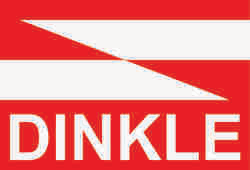
DINKLE Corporation USA
DINKLE Corporation USA is a leading international manufacturer specializing in terminal blocks. With a global presence, DINKLE provides reliable and high-quality products to various industrial sectors worldwide.
DINKLE's terminal blocks are widely utilized in diverse industries such as Factory Automation, Process Automation, Power Automation, Railway Transportation, New Energy, and Equipment Manufacturing. These essential components play a crucial role in ensuring secure and efficient electrical connections within these sectors.
One notable advantage of DINKLE terminal blocks is their ubiquity in industrial settings. Their products can be easily found and integrated into numerous applications across different industries. This widespread usage highlights the trust and confidence that professionals place in DINKLE's solutions.
To ensure the utmost quality, all DINKLE factories have obtained ISO 9001 and ISO 14001 certifications. These globally recognized standards validate DINKLE's commitment to consistent product excellence and environmental responsibility.
Moreover, DINKLE's terminal blocks boast several safety approvals, including UL, CUL, CSA, VDE, and GB certifications. These approvals signify that DINKLE's products meet rigorous safety standards and regulations, ensuring the utmost protection for users and equipment.
In addition to safety certifications, DINKLE also prioritizes environmental sustainability. The materials used in manufacturing their terminal blocks comply with RoHS and REACH environmental standards set by the European Union. This dedication to eco-friendly practices highlights DINKLE's commitment to reducing its environmental footprint.
In conclusion, DINKLE Corporation USA is a prominent global manufacturer of terminal blocks with a strong presence in various industrial sectors. Their products are renowned for their reliability, safety certifications, and compliance with environmental standards. Professionals across the world trust DINKLE's terminal blocks to provide secure and efficient electrical connections in their applications.
Multifunction
Results:
Results remaining:0
Applied Filters:
DINKLE Corporation USA
No data |
About Multifunction
Multifunction sensors and transducers are advanced devices that combine two or more individual sensors with integrated driving and output conditioning circuitry. These sensors are designed to provide a comprehensive range of data, and they typically utilize a single output type for communication purposes. The output can be transmitted via various industry-standard interfaces such as Bluetooth, USB, CAN bus, Ethernet, I2C, SPI, or RS-485. One example of a multifunction sensor is the accelerometer-magnetometer combination. This sensor incorporates both an accelerometer, which measures acceleration forces, and a magnetometer, which detects magnetic fields. By combining these two sensors, it becomes possible to obtain accurate information about both linear motion and orientation relative to the Earth's magnetic field. Another example is the humidity-pressure-temperature sensor. This multifunction device integrates sensors for measuring humidity, atmospheric pressure, and temperature. By combining these measurements, it becomes feasible to gather comprehensive environmental data, enabling applications such as weather monitoring, HVAC control, and indoor air quality assessment. There are even more sophisticated combinations available, such as the humidity-light-pressure-sound-temperature-tilt-vibration sensor. This multifunction sensor incorporates multiple sensors to measure humidity, light intensity, atmospheric pressure, sound levels, temperature, tilt angle, and vibration. This extensive range of measurements allows for detailed environmental monitoring and analysis in diverse settings, including smart buildings, industrial automation, and IoT applications. Another common combination is the accelerometer-gyroscope sensor. By integrating both an accelerometer and a gyroscope, this sensor can simultaneously measure linear acceleration forces and rotational movement. This combined data is highly valuable in applications like motion tracking, navigation systems, and robotics, where precise motion detection and analysis are crucial. In summary, multifunction sensors and transducers combine multiple individual sensors with integrated circuitry to provide a diverse range of data. They utilize a single output type for communication and can be found in various combinations, such as accelerometer-magnetometer, humidity-pressure-temperature, humidity-light-pressure-sound-temperature-tilt-vibration, and accelerometer-gyroscope. These sensors find applications in a wide range of fields, including environmental monitoring, motion tracking, and industrial automation.
